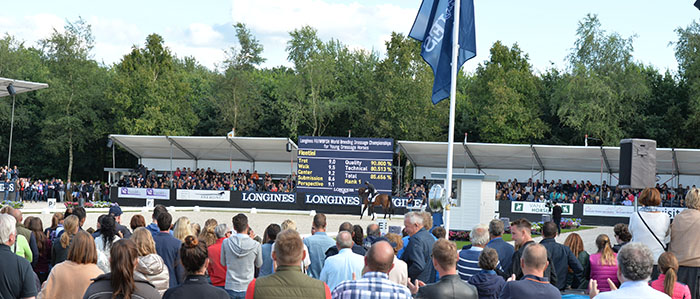
story – Christopher Hector photos – Roslyn Neave
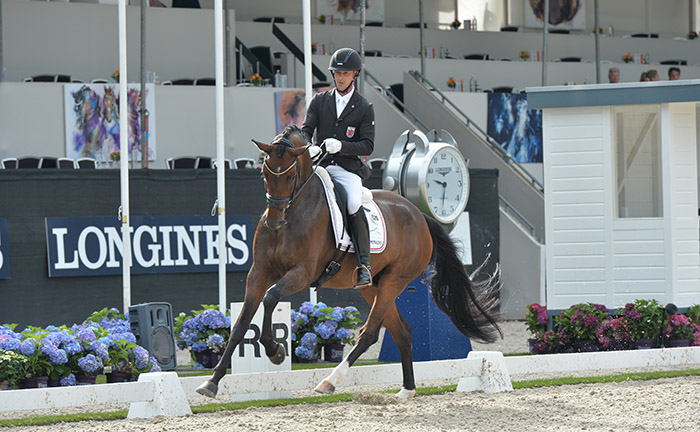
Quizmaster, first out the the World Young Horse Championships
The very first horse into the ring for the Five Year Old preliminary selection round set the tone for the 2017 World Young Dressage Horse Championships in Ermelo. The bay Hanoverian gelding, Quizmaster (by the Quaterback son, Quasar de Charry, out of a mare by Velten Third) was nice and neat, maybe he could have been a little more open in the gullet, especially for a five-year-old, but it was a very pleasant opening from Luxemberger Sascha Schulz. Trot – 8.3, walk – 9.3, canter – 8.5, submission – 8.2, prospective – 8.7, end score 8.6 and the pair will hold the lead for a while.

Score of 7.74 for Hollywood and Marjie van Kersbergen
The very next round is not so pleasant. The rider is leaning back about fifteen degrees dragging the horse’s head behind the vertical, with her hands ‘prammed’ to get a better grip. Oh yes, she’s Dutch, Marjie van Kersbergen, the mare, Hollywood, Dutch bred by Fürst Romancier out of a Johnson mare. It is a relief to see that the judges are not going to reward this sort of riding, 7.74.
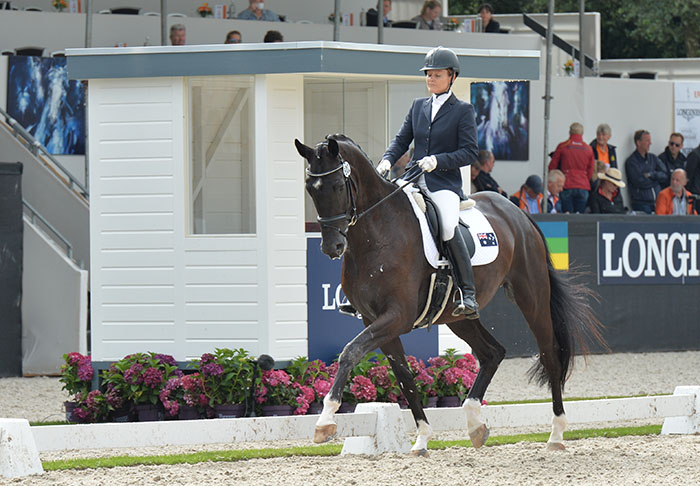
Rebecca Rooke riding the Trakehner, Muschamp Royal Black, and representing Australia
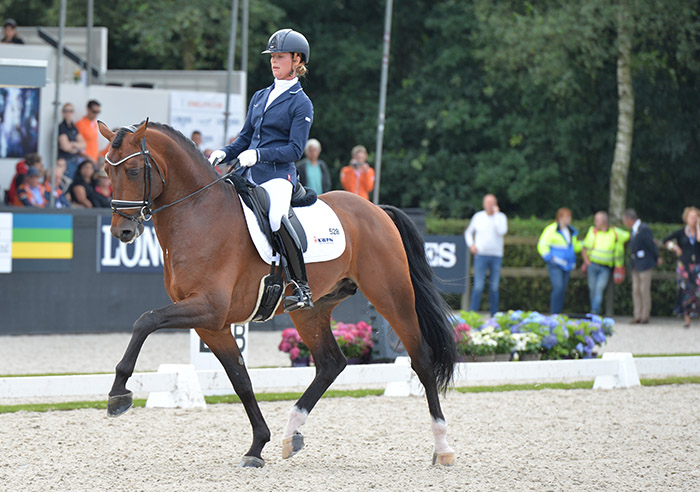
A workout for Adelinde…
Really Adelinde Cornelissen doesn’t need all those gym workouts, it would seem that just riding these days is an upper body strength intensive. You pity the Gelderland stallion, Henkie (Alexandro P / Upperville), he looks so uncomfortable, so restricted in front, the muscles of his neck are frozen solid, his back so tight that the movement cannot flow and the rhythm becomes choppy, and the half halts are simply vicious. What’s the line from Xenophon about nothing forced… Scores trot – 8.5, walk – 8.2, canter – 9, submission – 8.2, prospective – 8.7. Total 8.52, there is nothing like watching dressage to turn the most dewy eyed optimist into a hardened cynic.
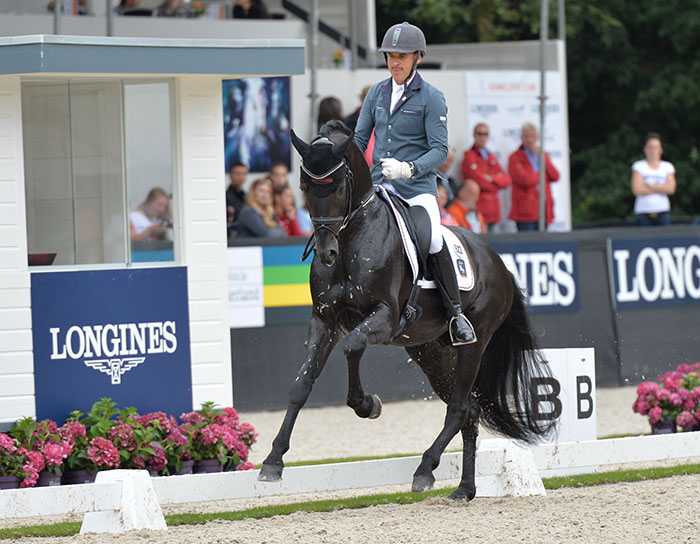
Nine for Revenant’s canter
Revenant (Rock Forever / Sir Donnerhall) is another five-year-old going on fifteen. The dark brown stallion is beautiful, he just doesn’t look like a five-year-old. Rudolf Widmann in the saddle is tactful enough, and the horse has a super big canter and shows our first really smooth canter / walk / canter transition. 9 for that canter and an 8.22 total.
Really that is the major Young Horse issue as I see it, particularly now with the introduction of the seven-year-old championship: the three divisions should be clearly deliniated, the judges should be looking for, and rewarding, a different outline, different qualities, and penalising horses that are being shown in a way inappropriate for their age and physical development. This might even involve tweeking the tests, to say emphasise natural paces for the five-year-old, the higher level of schooling for the six-year-olds, and the greater degree of collection for the seven-year-olds – while making sure that this class is still a young horse class, not another international Prix St Georges.
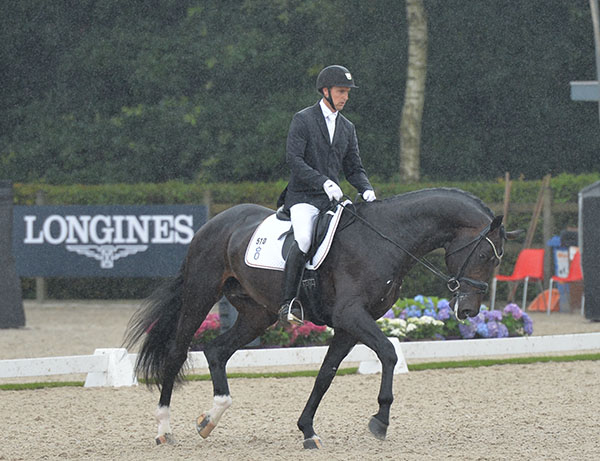
Swinging in the rain, Andreas Helgstrand and Ferrari
The last time I saw Andreas Helgstrand at a World Young Horse Champs was two years ago, when he caused widespread outrage at the roughness of his riding on the reserve champion, Fiontina, luckily her full sister, Fiontini scored higher and complete disgrace was avoided. It seems that Andreas may have learned his lesson, and with the addition of Ulf Möller to the Helgstrand camp, the riding style has undergone a largish change. Andreas is riding Ferrari OLD more like a stately BMW. The glorious brown stallion is by Foundation out of a Hotline mare, and the horse is nicely, relaxed and swinging through the body, and instead of the tail helicoptering in futile protest, it is quietly and rhythmically waving from side to side. 9.8 for trot, 8.5 walk, 9.6 canter, 9.5 submission and prospective, 9.7 for a 9.42 total and the lead.
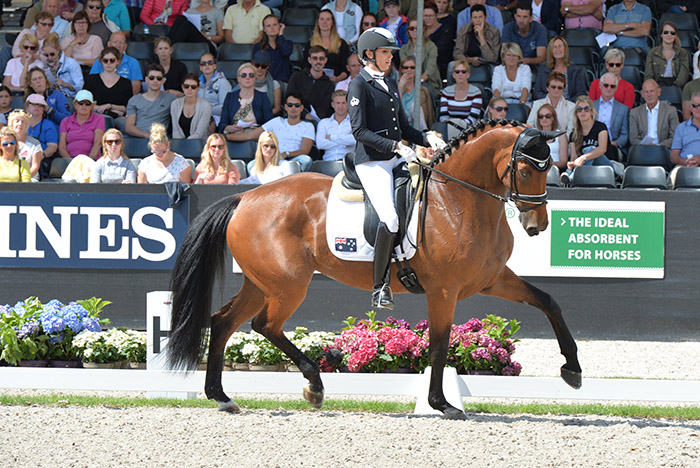
All power, Casablanca with Simone Pearce for Australia
Simone Pearce has been working at Helgstrand Dressage for the last couple of years, and she is riding a star in Casablanca. The horse is interestingly bred – all jump on the top line: her sire Conen is by Chequille Z by Caretano, out of a mare by the Landadel son, Land Classic. Casablanca is all dressage on her dam’s side – Fidertanz, Weltmeyer, Bolero.
What a powerful mare this is, but the trot is seriously passagey – and I’ve always understood that fake passage is a young horse evasion and to be avoided. The canter is genuinely huge, and Simone is really showing with style. I must say I am a little flabbergasted when the scores come up, that passagy trot scored a 10!! Walk is 8, canter 9.5, submission 8.8, prospective 9.5, for a total of 9.16, and Simone is second behind Andreas.
Later judge Dietrich Plewa explains at the Press Conference that there is a difference between tension inspired passage-like trot, and passage-like trot that comes because the horse has such a natural talent. Sorry, no, first the young horse must go forward – I remember Kyra Kyrklund talking about riding a young Matador through the forest, and the stallion started to offer passage. No, said Kyra, we put that away for a couple of years…
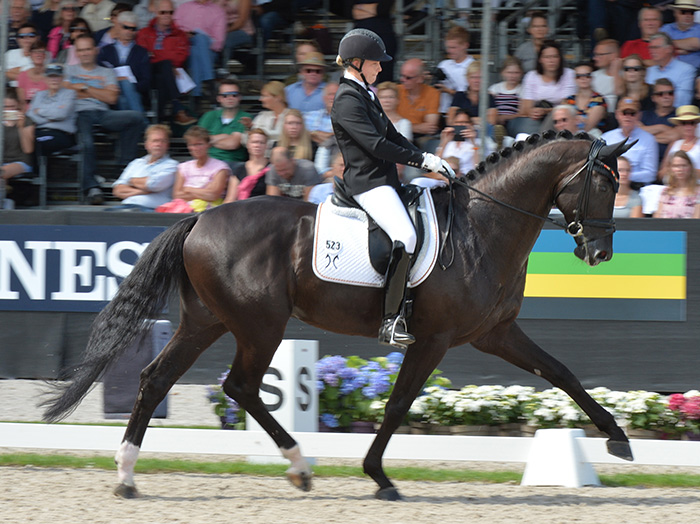
You don’t have to be spectacular to be beautiful, Don Martillo and Ann-Christin Wienkamp
There is one last twist of this first go round in the shape of the glorious black stallion, Don Martillo (Don Juan de Hus / Benetton Dream) ridden with sublime tact by Ann-Christin Wienkamp. They too score a ten for trot, but the stallion’s trot is very correct, his canter and walk are expansive for a 10 for the walk and a 9.2 in the canter. He drops his neck and relaxes beautifully on the trot circle, and picks up 9.8 for submission, and 9.8 for prospective, 9.76 to finish the first day in the lead.
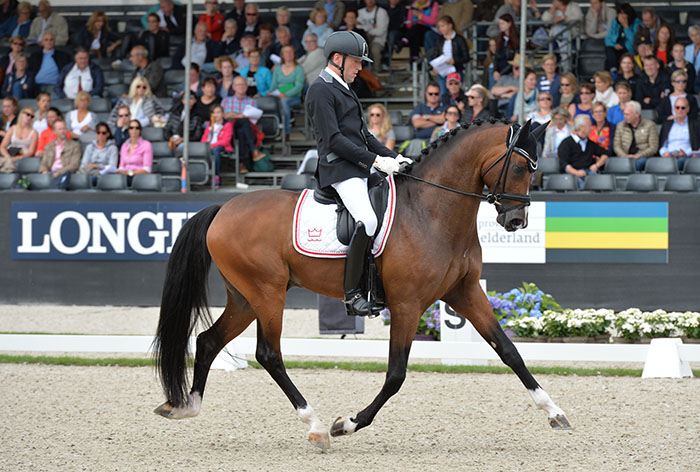
Donkey Boy, odd name, super trot
For some daft reason we have half the five and six year olds on day one, and the other halves on day two. It would have been much nicer to finish the fives on the first day, and the sixes on the second. As it is only the oddly named Hesselhoej Donkey Boy who is by the Donnerhall great grandson, Dancing Hit, with a Sandro Hit mother, out of a mare by the Michellino son, Milan moves up on the five-year-old standings out of the second round. The stallion is a lovely bright bay with an exquisite head, and while the rider is a little backwards thinking, the trot is super, the walk huge and the canter a delight. 9.7 for the trot, 9.8 for the walk, 9.5 for the canter, 9.5 for submission, and 9.7 for prospective, and a 9.64 total to leave them in second place going into the final.
next the 6yos
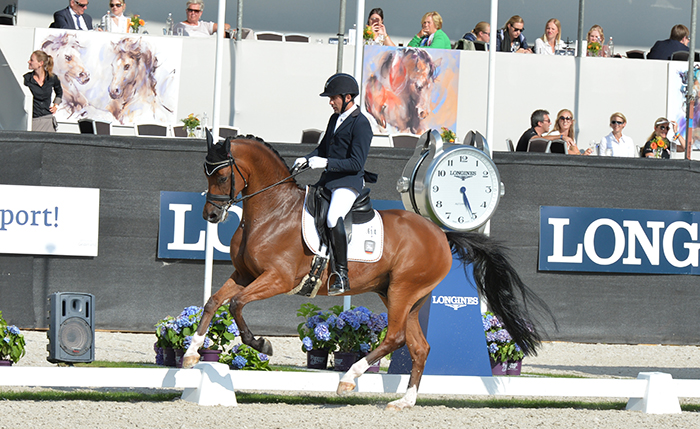
First out in the 6 Year Olds, Quel Filou and Servero Jurado Lopez
After the first day of the six-year-old class, the very first horse to go, the gelding, Quel Filou (Quaterback / Stedinger) is sitting pretty in the first spot on a score of 9.02 (8.8 trot, 9.2 walk, 9.2 canter, submission 8.5 and prospective 9.2). The horse is ridden by Severo Jurado Lopez, who has always been a softer, more tactful rider than his boss, Andreas Helgstrand, and he shows the bay nicely.
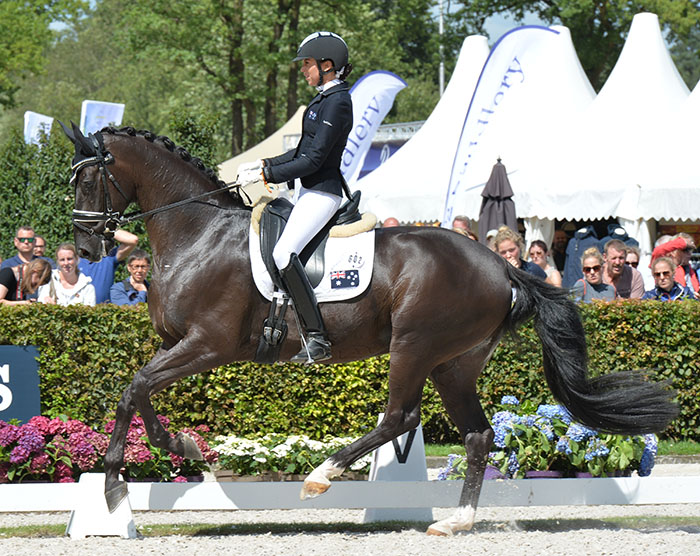
Leading going into the Final, Australia’s Simone Pearce and Feodoro
Keeping it in the family, another Helgstrand rider, Simone Pearce rises to the occasion in the second half, riding Feodoro. The gelding is by Fürstenball out of a Rosario / Dream of Glory mare. In truth, Feodoro goes just like his dam sire, Rosario, calm and sweetly expansive. The rhythm is absolutely relentless, and while the überstreichen is a little tentative, it has been a great test. Simone collects another 10, and this time deserves it, for the walk, 8.2 for the trot, 9.2 for the canter, 8.5 for submission and 9.2 for prospective for a 9.02 to lead going into the final.
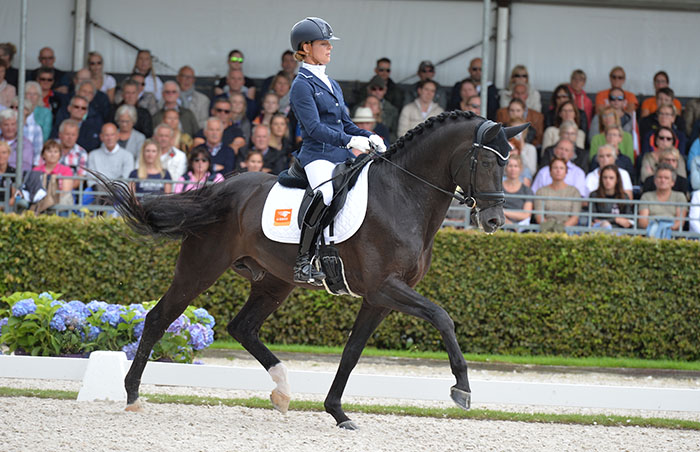
It is nice to see that Adelinde can ride more tactfully, and she shows the Totilas son, Governor STR (out of Parzival’s full-sister, Jazz / Ulft) for an 8.66 into 9th place.
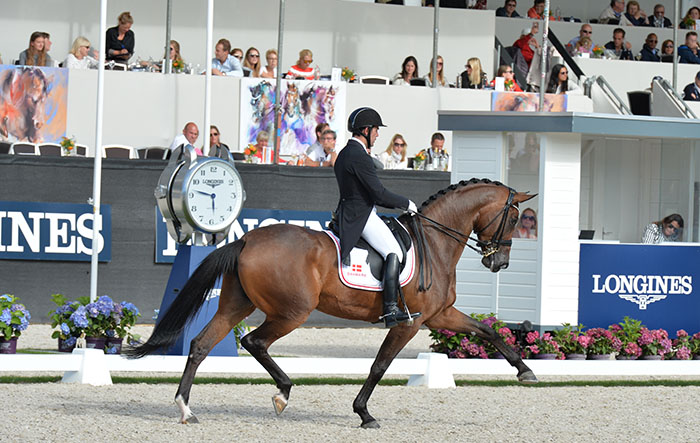
Fiontini – ultimate young horse star…
I hadn’t seen a seven-year-old young horse class before, and I really like the test, the movements flow logically one to the next, giving the riders every chance to prepare. Fiontini (Fassbinder / Romanov) was a sensation when she took out the five-year-old title in 2015. At the time, I interviewed Hanne Lund, who bred both Fiontini, and her full-sister, Fiontina (who finished a controversial second, ridden appallingly by Andreas Helgstrand) out of her Romanov /Solos Carex mare, and sired by Hanne’s stallion Fassbinder (Fürst Heinrich / Caprimond). Alas Fassbinder was a stallion no more, gelded when Hanne realised she could not compete against the high profile, ‘star’ stallions. Fiontina disappeared from view, but Fiontini continued her winning ways with Severo Jurado Lopez, taking out the Six-Year-old World Title at Ermelo last year, and now lining up to make it three in a row.
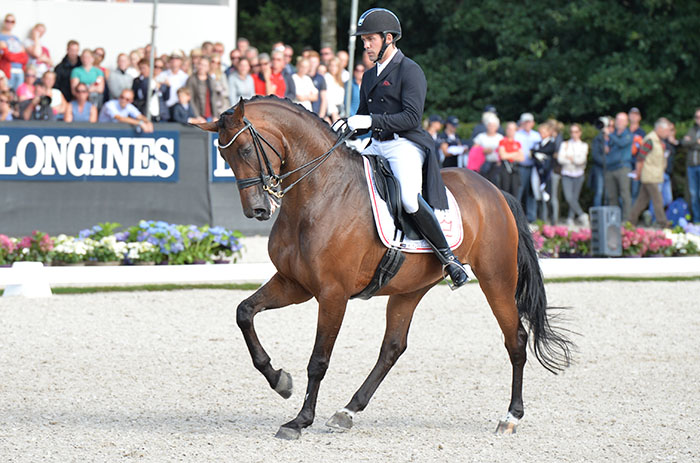
Danish mare, representing Spain with Severo Lopez
The Danish mare is representing Spain, a country she has never set foot on, and that really does pose some kind of question for the World Breeding Federation of Sport Horses Executive – who calls the shots for the World Championship. While the charter of the World Championships clearly sets out that riders should be mounted on horses bred in their own countries, this rule is more honoured in the breach than the observance. Smart operators soon grasped the idea that if they had a rider from a country that was not likely to produce any horses to fill their quota, then they had a great chance of slipping one of their horses into the lineup using their rider’s passport to get there.
As Klaus Miesner, the chairman of the WBFSH executive committee, pointed out to me, it is not a black and white situation. “Yes, in principal we want to encourage riders to compete on horses bred in their countries, but on the other hand, we want to encourage young horses classes all over the world. So if a rider from say Korea, comes to Europe to train, and then gets the chance to compete at the championships, this is a good thing in terms of promoting the concept in Korea.”
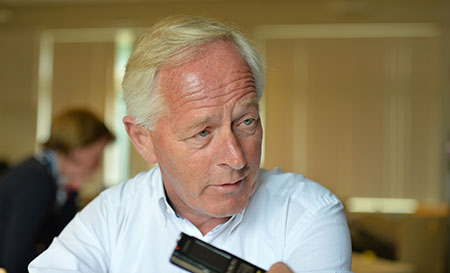
Time to get the view from the host country – Arie Hamoen was the chair of the KWPN dressage stallions licensing committee from November 2003 to December 2012. As an official he was refreshing in his frank assessments, and retirement has not dampened his willingness to tell it like he sees it…
What are your impressions of the horses at this year’s championships?
“My first impression is that the basic rideability is better, the horses are more comfortable in the rings. This arena is more closed than in Verden but the horses are coping. It is maybe a point of attention of the breeders, and I think it is better than we have seen in the past. Okay sometimes it is hard to find the balance between talent on one hand, and rideability on the other. With young horses sometimes you have to accept it when a talented horse makes a mistake.”
Do you think it might also be because the riders are riding the horses quieter and more sympathetically?
“I think the riders know better what the judges like to see, but again you have to be careful – if you are riding ‘too friendly’ with the contact too free, then sometimes the use of the hind legs becomes not so good. The riders have to find the balance – not too free, not too short. It’s a hard balance.”
Is it a hard balance for the breeder to produce a horse that will do well in young horse classes but also go on to compete at Grand Prix?
“When you give maybe too much attention to the rideability for the young horse classes, and you lose the activity of the hind leg, then you don’t have a good selection for the top sport. We know in the Grand Prix you need power behind, but when you have too much power behind, then sometimes it is very hard to present that horse for the young horse competition. When your breeding goal is the Grand Prix, then you have to accept that for the young horse competition, sometimes the horse is over-active and maybe the harmony is not there.”
When we look at the type we see here at the young horse classes, it is not the same type we see at the top competition: Totilas, Valegro, Verdades, they are rather old fashioned…
“I think it is a point of attention with the young horse judges that sometimes they give too high marks to the horse that has a lot of balance in trot, a lot of balance in walk, but no power behind. It looks very nice now as a young horse but when you look to that point on the horizon, the Grand Prix, then in my opinion there should be more attention to the power behind. And they should be careful with the walk, I hear the judges talking about over-step in the walk for the young horses, but the riders know how difficult it is to collect that walk.”
Do you think that it is almost as if we are breeding two streams of horses, you breed to a Grand Prix stallion like De Niro or Gribaldi, and you get a good chance of a Grand Prix horse, or you breed to a horse that has never done anything but young horse classes and you get a young horse class result…
“The judges have to realise that they should ask themselves – is this a potential Grand Prix horse? I hope in the future that the young horse judges give a little more attention to the breeding goal, which is to breed a Grand Prix horse. It is hard to look at a five or six-year-old horse and say how it will go in top sport, but in my opinion there should be more attention to the power behind. And the activity and clarity in the walk, not just the over-step – over-step is one point, but the other point is activity and clearness.”
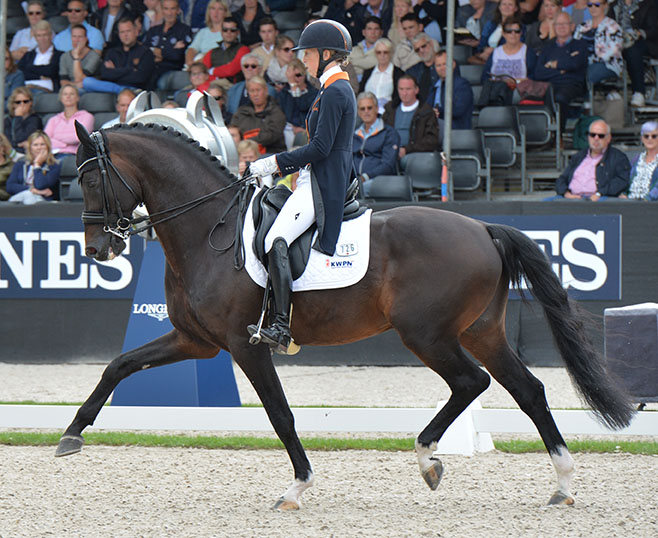
Ferdeaux, 4th in the 7yo Final with Kirsten Brouwer – GP genes
Is it important to breed to a stallion that has competed Grand Prix or has progeny that have competed Grand Prix?
“On the other hand, we also have to test the younger stallions, otherwise we will never know what they can do. Of course I like to see Grand Prix in the pedigree, take our horse, Ferdeaux who was 4th in the first round of the seven-year-olds. The father, Bordeaux is now Grand Prix and on his pedigree two Grand Prix – Krack C and Gribaldi, then comes Ferro. Ferdeaux’s oldest offspring are two-year-olds, with good results – but when you look at his pedigree you see lots of Grand Prix. Of course I can understand why the breeders want to use proven stallions, yes Grand Prix is important, but also the pedigree is important.”
“You also have to remember that sometimes the Grand Prix horse is made by the rider and not made by the genetics. When you use a Grand Prix stallion you should also pay a lot of attention to his pedigree if there are Grand Prix stallions before, then you can use the stallion, but there are Grand Prix stallions where you cannot find any Grand Prix genes in their pedigree, then stay away from those stallions. Oh you can say ‘it’s an outcross’ and ‘he works on the highest level’ but the DNA says no. You must remember with a stallion that Edward Gal is riding, the offspring are coming from the stallion, not from Edward. The problem for the breeders is that when they go to the younger stallions they look hard at the pedigree, but when they go to an older Grand Prix stallion, then they are not so careful with the pedigree. For both, the pedigree is important, that’s the warning I give to breeders.”
In Germany this year, they recognized the difference between the stallions that sire good young horse competitors, and stallions that sire open competition horses, and they made two sets of breeding values – is that a possibility with the KWPN?
“You can see it also in our index. If you see a young stallion, and his index is high, then you know his offspring are easy to handle and good in young horse competitions, but when the offspring are older, and the index goes not up, then you know, go away from that stallion. For example Jazz, he started good in his index, good not extremely high – we know they are a little bit spooky, rideability is a point of contention – but as the offspring got older, you saw so many competing in the higher levels and his index goes up and up. We are thinking and talking about the same things as the Germans.”
Looking to the future, do you see any changes in the direction of breeding in Holland?
“Yes. The breeding goal is never one point on the horizon. We have had a lot of influence from Jazz in the past and now we look more to the rideability. We didn’t forget it in the past, but good stallions have good points and points of attention. Now in our breeding goals there is a little more attention to rideability than five or ten years ago.”
Which stallions would you be looking at for the future to improve rideability?
“Some German stallions for example, Belissimo, even though some of them are hard to handle, Desperados, we need the D line. We tried with Donnerhall himself twenty five years ago in Holland, but maybe at that time it was too early, it didn’t work. With our type of horse, at that time, it didn’t work. You have to look to your mare population, but now I think the D line is more successful with our mares, I hope so.”
Are you sad that there has been no Jazz son to really stand up and say – I am the heir?
“Vivaldi is coming up. The rideability is good and the first sons are knocking on the door of Grand Prix. The only problem for Vivaldi is the quality of his semen. Vivaldi’s sons are also knocking, Dream Boy for example. Vivaldi is putting the next step in the line of Jazz.”
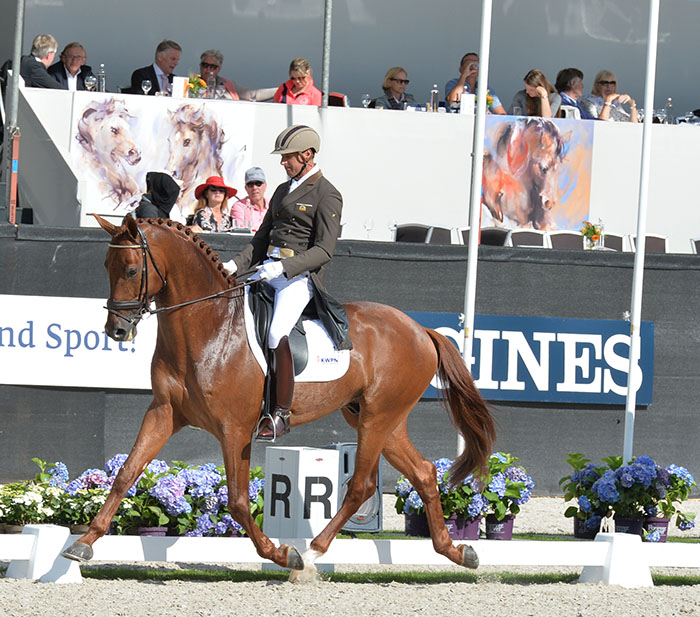
Fourth in the 7yo Final, President’s First Apple with Patrick van de Meer. The stallion is out of a Partout mare, and by Vivaldi – will Vivaldi carry on the line of Jazz?
Three years ago, when Fiontini appeared on the scene at the last minute to rescue the five-year-old title from the clutches of Andreas Helgstrand and her full-sister, Fiontina, we were so relieved that we were prepared to overlook certain deficiencies. Now after she has carried Severo Jurado Lopez to the triple crown – five, six and seven year old champion – you sound slightly cracked suggesting that the mare never shows throughness and softness and movement through the back, she is stuck in an outline and has progressively lost her swing as time goes bye. She scores 85.656 so what do we know?
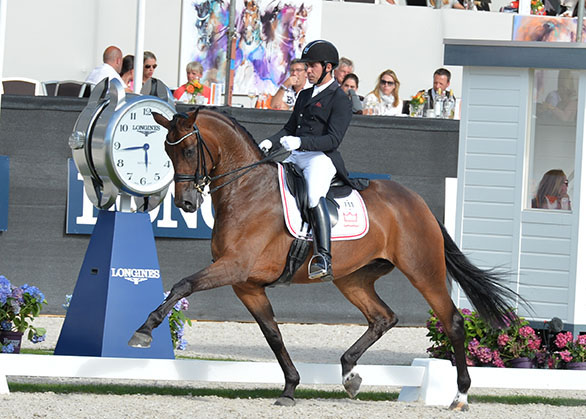
Three-peat for Fiontini
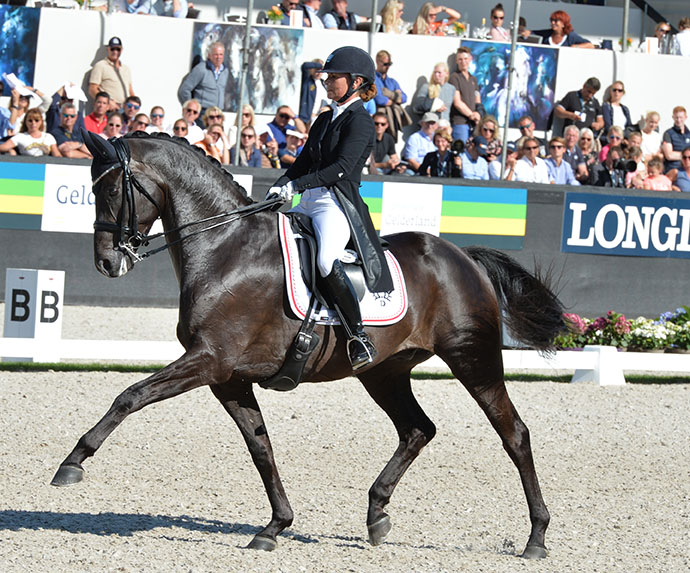
Trakehner charm, Kipling
Truth is, we would have preferred the horse that finished third, Kipling, the sweetest Trakehner (Hofrat / Hohenstein) from Denmark, ridden correctly and sympathetically by Anne Troensgaard. The bay spooked off the track at one stage and the rider had to circle and get back on the pattern but the rest of the test was delightful. They scored 82.445. There were three Trakehners that made this final, the other two were by Hubertus Schmidt’s Grand Prix horse, Imperio.
The second place went to Sultan des Paluds (Soliman de Hus / De Niro) ridden for Holland by Kirsten Brouwer – the back was so tight, the chestnut gelding is a real leg mover. 83.515.
Sunday, final day, and the sun is shining for the Five-Year-Old final, or it is right up until the end of the class with a slightly damp presentation…
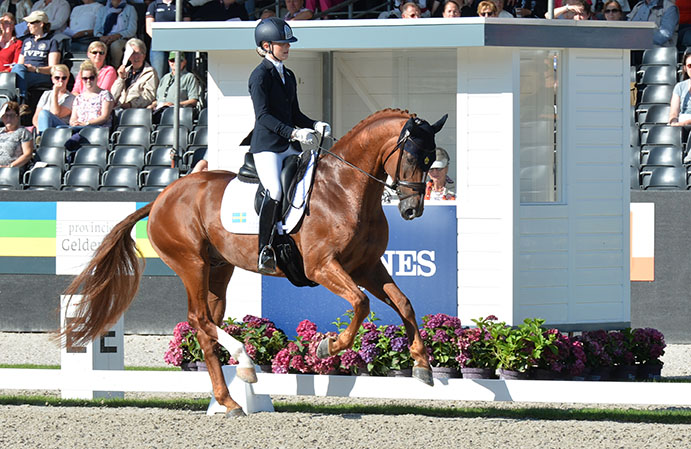
Dragon Welt and Ida-Linn Lundholm, 9th with a score of 8.72
The first horse to go, Dragon Welt represents Sweden, but is of impeccable Hanoverian breeding, by Dancier out of a Weltmeyer mare. A glorious chestnut stallion, its skin glows in the morning sun. Ridden by Ida-Linn Lundholm for Jan Brink’s Tullstorp Stables, the horse is just a bit short in front, nothing horrible but if he could open his gullet a smidgeon the movement might flow better over his back. It’s a fine test and a lovely way to start the day.
The judges are in separate boxes but can talk to each other to come to a consensus mark, with Christoph Hess at C explaining the numbers. I like this system, the judges have to give reasons and you are less likely to get one loopy score affecting the result. Christoph is his usual enthusiastic self and is happy to pay an 8.72 for this stunning debut.
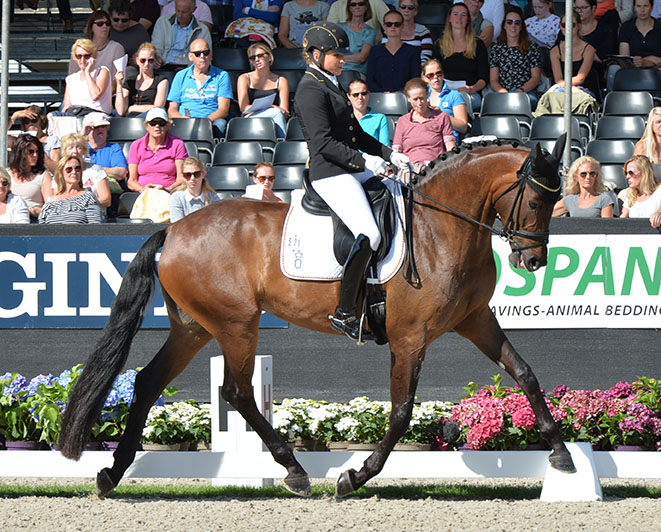
Sisters Act – ‘nice to see natural movement’.
The next to shine is Sisters Act OLD (Sandro Hit / Royal Diamond) with German ace, Dorothee Schneider scoring a neat 9. The trot is cadenced without being passagy, super unhurried medium, every step identical, great canter, and fabulous transitions. Christoph reports the comment from Australian judge, Susie Hoevenaars – ‘three good natural paces’. I feel there is not sufficient distinction in what the judges are looking for in the three classes, there are horses in the five year old division who look like Grand Prix horses. What was it that Pluvinel wrote of young horses ‘being careful not to annoy him, if possible and not to rob him of his gentleness, since the horse is as the blossom is to the fruit, which once withered, never returns…’
Dorothee finishes in equal fourth with Simone Pearce and Casablanca who looks a little tense, not so passagey but just a bit tight. Christoph says “we saw elasticity, power, impulsion but not always swinging over the back.” Simone scores 9.5 for the trot, 8.8 for the walk, 9.5 for the canter, 8.3 for submission, prospective 9. What a show for Simone and she still has the six-year-old class, which she is leading, to go.
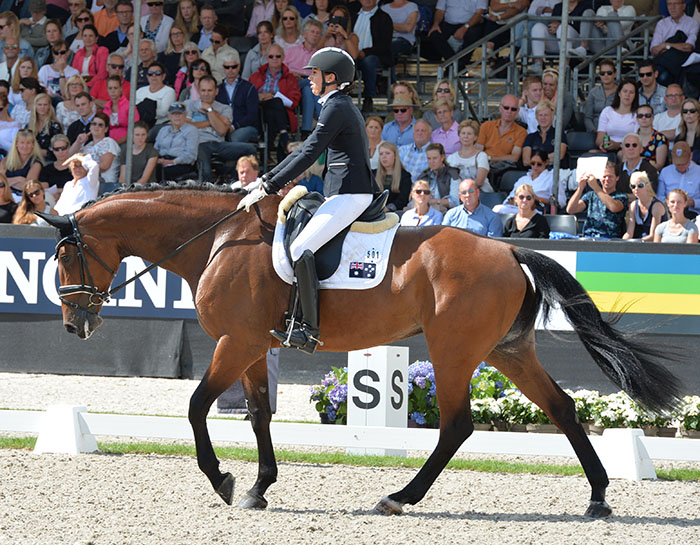
Casablanca and Simone Pearce, starring for Australia
Simone’s boss, Andreas has Ferrari a little more revved up today, but not outrageously so. This is a truly amazing mover although the rider is working hard to keep the counter canter happening. Once again, Christoph is reaching for the superlatives – “powerful, unbelievable – we like the relaxation after the test”, as Andreas circles the arena on a loose rein for the comments.
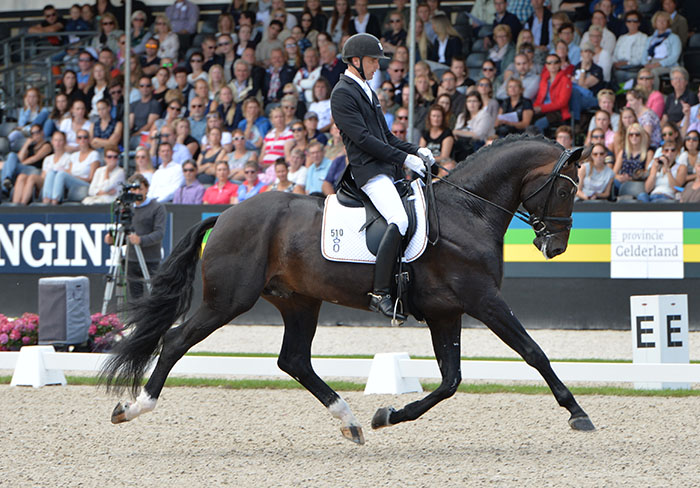
Ferrari, trot – 9.7, walk – 8.5, canter – 9.5, submission – 8.8 and 9.5 for the prospective.
A total of 9.2.
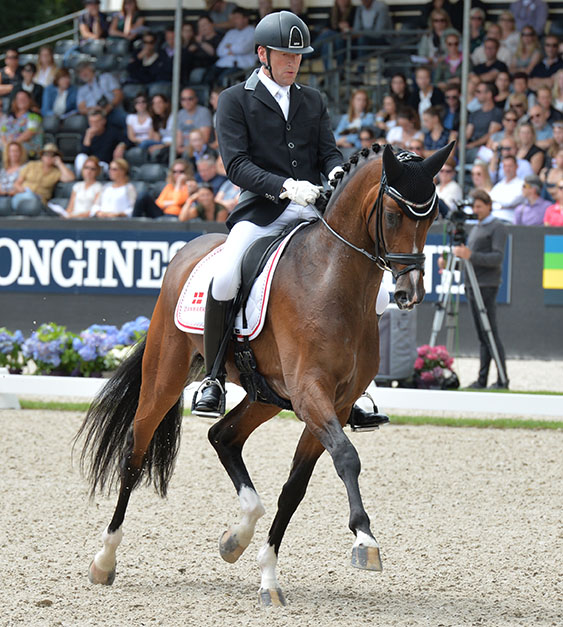
Donkey Boy delights
The delightful Donkey Boy slips into 3rd on a score of 9.1, just behind Andreas and Ferrari, but it’s a clean sweep for Don Martillo. The stallion is just an effortless mover, gravity doesn’t seem to bother him, he floats, he glides, he flows. And in Ann-Christin Wienkamp, he has a rider perfectly in tune with the horse, and respectful of his age and level of development.
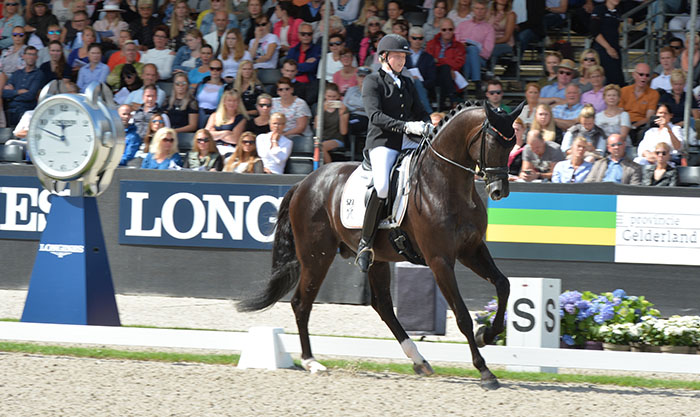
Don Mantillo and Ann-Christin Wienkamp, the Dream Team
“Judges like to use 6.5 but when we see a horse like this, we need 9s. This really is the Dream Team. What do you think the best gait was?” Christoph asks the spectators.
“The walk.”
“And the score?”
“10,” they cry in unison. And ten it is. It is 9.7 for the trot and the same for the canter. There’s a 9.5 for the submission (“This horse is being trained 100% the right way.”) and a 9.7 prospective for a total of 9.74 and Don Martillo is the champion. And what a champion.
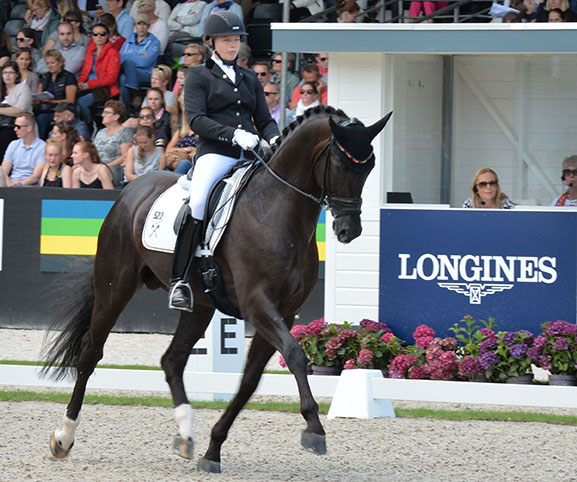
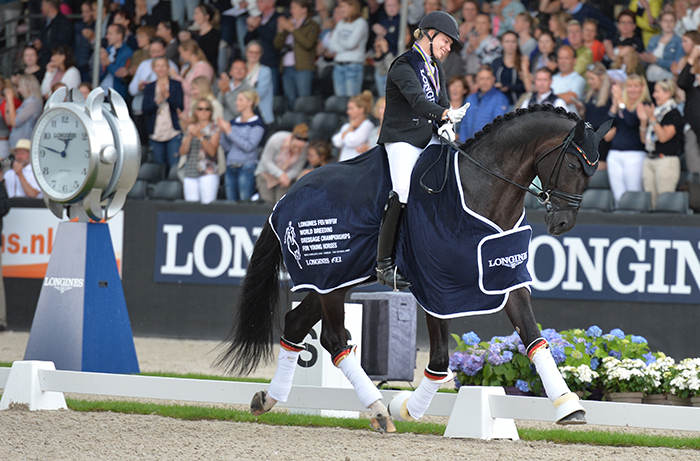
Showing off his 10 trot, Don Mantillo
Journalism is 90% luck. Here’s the latest example, I was watching the second round of the six-year-olds. The press facilities are pretty minimal, but up the back of the little stand there is a row of seats – Photographers Only. I may not be a photographer but I am wearing a press pass, which is more than can be said for the spectators who have ignored the signs and occupied all save the last two seats in the row. I grab both since the weather at this show is wildly unpredictable and I am now loaded with lots of excess clothes, which I deposit on the second seat. That is until I see my friend Susanne Miesner scanning the stand looking for a place to sit. Here! Whereupon she introduces me to the gent in the next seat, it’s Axel Windeler, highly successful breeder of Hanoverians, and the breeder of Don Martillo. But wait, it gets better…
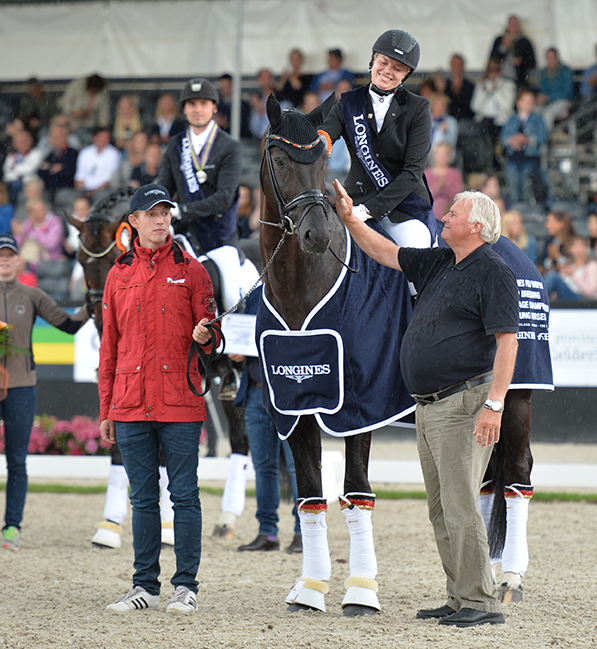
Proud breeder, Axel Windeler, and his 5yo Champion, Don Martillo
Not only does Axel speak excellent English, but he is also a real breeder and his connection with the leading stallion goes back four generations. He is a thinking breeder with a well worked out strategy, although that wasn’t the case when he first tried back in 1977, for the usual reason, the mare was not good enough to ride, so let’s breed with her!
Always a great idea…
“Not a great idea… I tried with the mare, but it was not very good. I tried then with another mare, and I tried over ten years and I was not so successful. I thought it over, and in 1988, I bought the great great grandmother of Don Martillo, Wennings, she was Wenzel / Shogun xx. She was from a good breeder in Verden, he had bred many show horses and auction horses, and they also had high prices. I liked his horses, they had very good movement, and they were beautiful, big and a dark colour, dark brown or black. So I bought this mare, and in the beginning it was not so good. She had two by Rubinstein, normal trot, I was not satisfied – and then I started breeding with the Anglo Arab, Matcho. The Matcho foal was very good, she was my first mare to go best of the show, three times. Matchos did not have the biggest movement, so I decided for Warkant, because Warkant gave very good movement. Then I brought that mare, Wendy For Ever, to my own stallion, Benetton Dream, and her foal, Black Pearl, to Don Juan de Hus.”
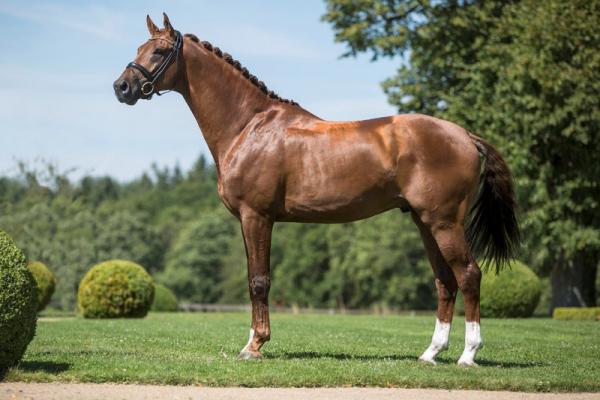
Don Juan de Hus
“In this period, 87 to 93, I bought another five mares, top mares. For example, Windrose, the vice European champion mare in Brussels. With her I had a good start, she brought my first licensed stallion, Winterprinz (by Warkant), who I sold to America for a very good price. With Windrose, who was Weltmeyer / Sender, we made a new line. Windrose with Davignon, produced Dornroschen, who bred with Rotspon produced Rotkappchen, who bred to Brentano II produced Benetton Dream.”
“Benetton Dream was champion at the Bundeschampionate in 2007.”
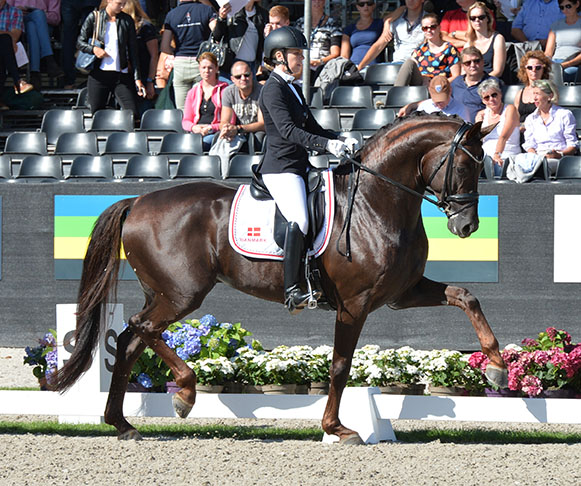
Botticelli by Benetton Dream from a Caprimond mare, the full sister to Cassidy who competed in the Danish Nations Cup team at Aachen. Botticelli competed for Denmark in the 5yo class at the WYH Championships
Why did you go to Brentano II?
“I liked Bolero but I came too late for him, he died before I decided for him. I decided for Brentano because there was a magazine with the top ten breeding stallions. There was Donnerhall, Rubinstein, Weltmeyer and Brentano, so when I took my mare to Brentano, I had combined all five of the top – and the result was Benetton Dream. And it was a very special offer from the State Stud at Celle, €450, so it was easy to try.”
“It was the same with Don Juan de Hus, he was €700 and payment when the foal is there, that was also a good offer. I had sold to Haras de Hus, a five-year-old horse that they took to Grand Prix, and after that we were in contact, and swapped frozen semen from my stallion Royal Classic, for semen from Don Juan, so I have several Don Juan at my home.”
“I saw Don Juan at the licensing at Münster / Hahndorf, and he was great. Trot unbelievable, canter unbelievable, walk normal. He was a good type – he was Jazz / Krack. It was a little bit luck, this stallion was from Haras de Hus, and I was already in contact with them, so you need a little luck, but he is a great horse.”
You didn’t worry about the Jazz temperament?
“No. I thought at this time, we had a mare with a very good walk and super trot, and I needed to improve a little bit that canter, and he is unbelievable in canter. Don Juan and Benetton were at the same stallion station, and sometimes they were riding both at the same time and I saw this combination and thought, this is a good idea. And now we are here…”
“As a foal Don Martillo looks very good. Then he grew up and I saw his good movement. When he was three years old, I have to give him a name, and I had read about a Thoroughbred called Martillo – that means ‘hammer’ – and I had this in my mind and said, when I have a good horse, I will call him The Hammer. Martillo in Spanish.”
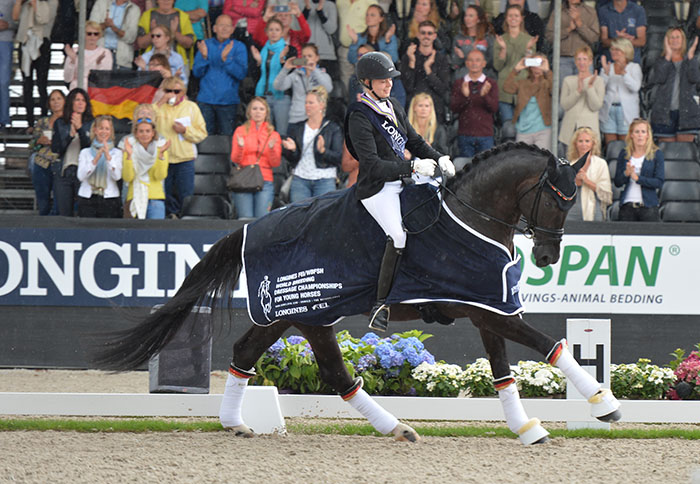
The Hammer, champion 5yo
“We started when he was four years old and he was a winner but we had to give up because my rider was not good enough for him. Then I decided on Ann-Christin Wienkamp and she rode him one week before the Hanoverian Championships, and four weeks before the Bundeschampionate, and he was the winner. That was very successful.”
It is such a relief to meet a real breeder, not some rich guy who bought a mare six years ago already in foal…
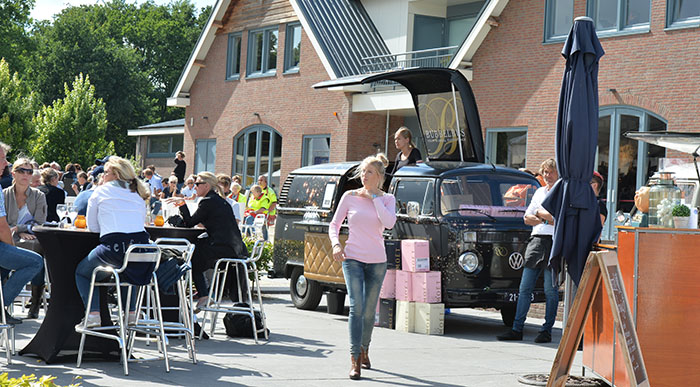
It’s hard to believe that we have come to an end, the last class of these championships, the Six-Year-Old Championships. The first horse to get amongst the points was the Oldenburger stallion, Sir Skyfall OLD (Sandro Hit / K2). Correct, not exciting, but correct, and quietly ridden by Frederic Wandres for an 8 for trot, 9.5 for walk, 9.2 for canter, 8.7 for submission and 8.9 for potential, total score of 8.86.
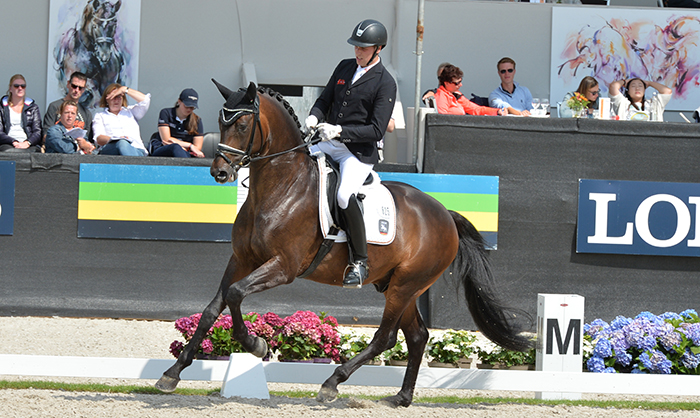
Sir Skyfall, correct, but not exciting
On my maths, the two Totili competing here must have been conceived before the (in)famous sale to PSI when the black stallion was being offered on a very limited basis before he went to Schockemöhle and semen sold to a carefully selected couple of thousand at an outrageous price. The first in the final is Don Tamino, out of a Don Schufro mare. It’s a bit of a sweet pony, scoring 8.3 for trot, 8.4 for walk, 8.7 for canter, 7.8 for submission and 8.5 for prospective, and a 8.34 total.
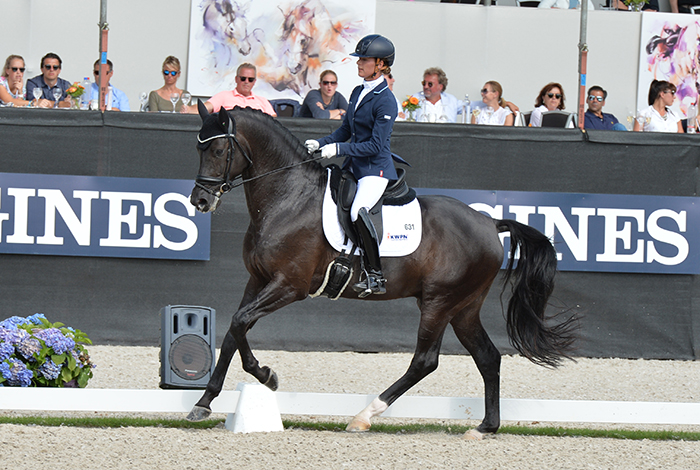
Governor-Str, by Totilas, out of Parzival’s full sister
The other Totilas in the field does better, and you would think genetically that was on the odds, since Governor-Str is out of the full-sister to Parzival (Jazz / Ulft). I remember Governor from the stallion licensing in den Bosch, and he had an elegant stretchy outline – not now, he seems to operate in a permanently shortened frame. If you can live with the outline, it’s a pretty good test. There’s 9.3 for the trot, 8.8 for the walk, 9 for canter, 8.9 for submission, and a 9.3 for potential. That’s 9.06 and they are in the lead.
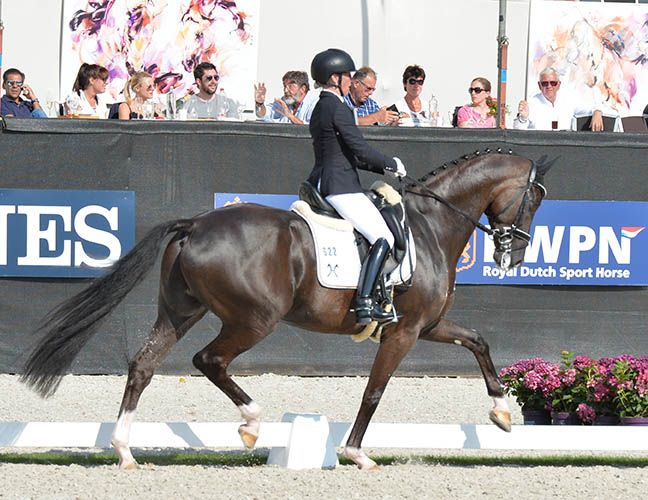
Worth waiting for, Lordswood Dancing Diamond and Anne-Kathrin Pohlmeier
‘Wait!’ says my incredibly well-informed German pal with a discerning eye, ‘Lordswood Dancing Diamond is coming, and he is, in my opinion, the best horse in Germany, the best I have seen.’ Better than Isabell Werth’s Bella Rose? Equal. The test doesn’t start that way, there’s an awful halt before the dark liver chestnut gelding gets into his extraordinary trot, extraordinary in its correctness. As British judge, Andrew Gardiner, who is doing the comments at C points out, “this is a very natural talent, the trot had quality and expression and super contact. Ten.” The walk was a 9.3, the canter 9.5, with the judges loving the hindleg that came right under the body. For submission, Andrew praised ‘the wonderful smooth contact, and the light forward tendency.’ 9.8, and the prospective mark? 10. A total of 9.72, and the new champion is a shining example of just how young horses should be ridden and trained. Bravo.
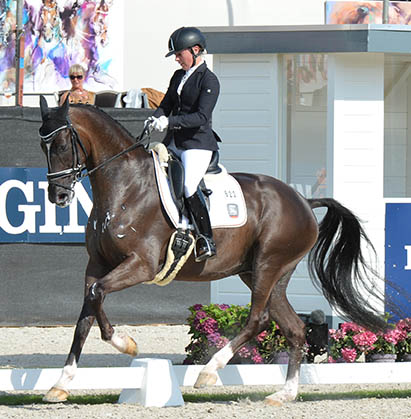
Dancing Diamond shows a 9.5 canter
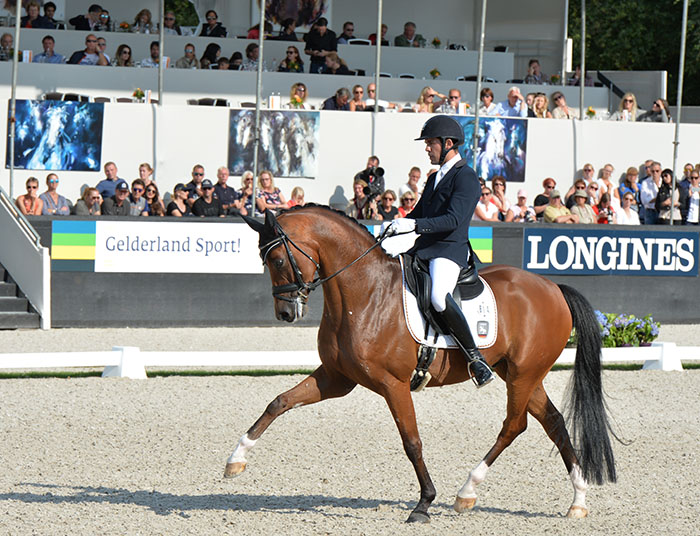
Severo Jurado Lopez, up to third on a count back
This time it’s not over until the fat lady calls a press conference, this presser is opened by the TD confessing that they’d got it wrong. Severo Jurado Lopez and Quel Filou (Quaterback / Stedinger) had an error of course when they turned left instead of right in the walk, but when they calculated the score they got it wrong, and in truth Severo was third not sixth, with a score of 8.99. Beautiful trot, massively free shoulder – 9.8, walk, clear and marching, 8.5, canter powerful, good hind leg, 9.5. Submission, 8 and 9.4 for potential.
more below
Interested in breeding a dressage star? The best bloodlines in Europe are available in Australia – including most discussed here. Go to www.ihb.com.au
My pal at the Hanoverian Verband, Ludwig Christmann, tells me that earlier in the day he rang the breeder of Lordswood Dancing Diamond, Heinrich Ebeling, an older breeder from the Stadt area. Mr Ebeling was not coming to the show, he was going out for a carriage ride. Dancing Diamond is another product of a serious breeding program and his pedigree is a pantheon of the heros of Hanover: Woermann (x2), Ferdinand, Grande and Duellant with just 27.54% ‘blood’ from the great Der Löwe, and more recently from Lauries Crusador, the sire of Dancier’s dam sire, Lancier. Mr Ebeling purchased Waluga, the Hanoverian representative at the National Mare Show 1986, and bred her daughter, Waluga II by Wolkenstein II (that’s line breeding to Woermann) and then bred Waluga II to Dancier for the Champion.
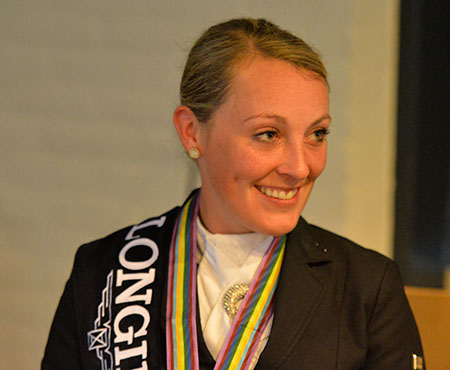
Anne-Kathrin Pohlmeier is another of those perfect interviews, she cries, she bubbles, she smiles, most of all, she radiates the very special relationship she has with her horse:
“I had an amazing feeling, I felt that Lordswood Dancing Diamond was concentrated completely on me and nothing else around him, he was asking what now, what now? and everything I thought, he did. I said to myself, Anne-Kathrin now it is your job to make it right and you better ride the best you can.”
But it must have been a bit of a fright at the beginning of the test when the halt went a little wrong?
“Oh no, that was quite okay from the feeling, he was not in tension, he was only saying okay, let’s do something. Standing is boring!”
You train with Hans-Heinrich Meyer zu Strohen?
“I would never have been here if I did not have him! He has trained me with the horse since he was three-years-old. He was just broken, and I asked Hans-Heinrich if he had a little bit of time to train the horse with me, because I was thinking it’s a good one. I took the horse there, and he said, ya, I think it’s a good one. And since then, all the years, we train together.”
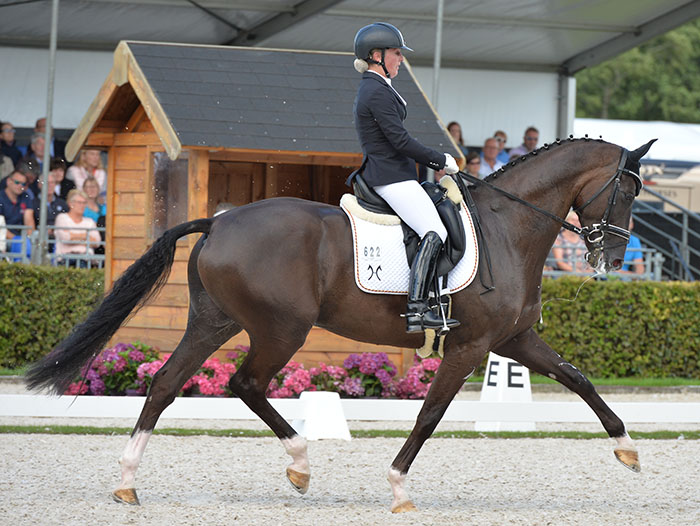
How did you meet the owners of the horse?
“It’s a bit of a funny story. I was riding the horse for the previous owner, and he was sold from a video to the present owners. They saw him for the first time live at the competition in Verden, at the Bundeschampionate qualifier. They asked me if I would like to ride him, and I said it would be a dream. I loved him from the first day I sat on him, I always had the idea that he was something special.”
You came here to the World Championships last year?
“That was the worst day of my life! I came to the warm up place, and they said, no it’s not allowed, only three horses before, so I went to a different place, came back, then my microphone doesn’t work. Someone changed it for me, then it fell out of my ear, then I had Hans-Heinrich in my ear, you have to go inside. No, I need thirty minutes more. So I only had twenty minutes. He needs to get used to the other horses, he needs to jog with a long neck, really deep, really slow, to make him easy and calm. You don’t have to practice the trot, it comes always.”
Do you think of yourself as a young horse specialist, or do you want to ride Grand Prix with this wonderful horse?
“I would say I am absolutely the young horse trainer, but for him, I would change my mind. Normally I love to build up the young horses, a step every day forward, sometimes ten backwards, then fifteen forwards. When you teach the horse something, that makes it so interesting for me.”
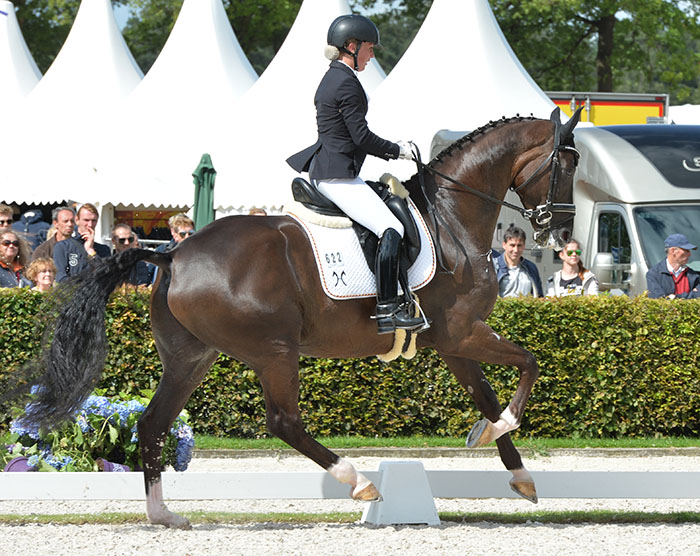
Have you ever ridden one like Dancing Diamond before?
“No and I think I will not ride a horse again with that partnership we have, sometimes I think he knows me better than I know myself, and sometimes I think I know him better than he knows himself!”
Breeding Breakdown
I suppose we could say Sandro Hit is really the patron saint (godfather?) of Young Dressage Horse classes. He was the first stallion to establish his reputation as a star at the Bundeschampionate, and then World Young Horse championships – retiring in 1999 from competition after his Six-Year-Old Titles, at the stage where stallions in the past were just beginning to forge the sort of reputation either through their own competition results, or the results of their progeny, that they needed to attract mares. On the basis of spectacular young horse successes, Sandro Hit became an instant hit – the most popular stallion in Germany and he sired an incredible number of licensed stallions. It is little surprise then that eighteen years later his line dominates the entries in the World Championships in Ermelo.
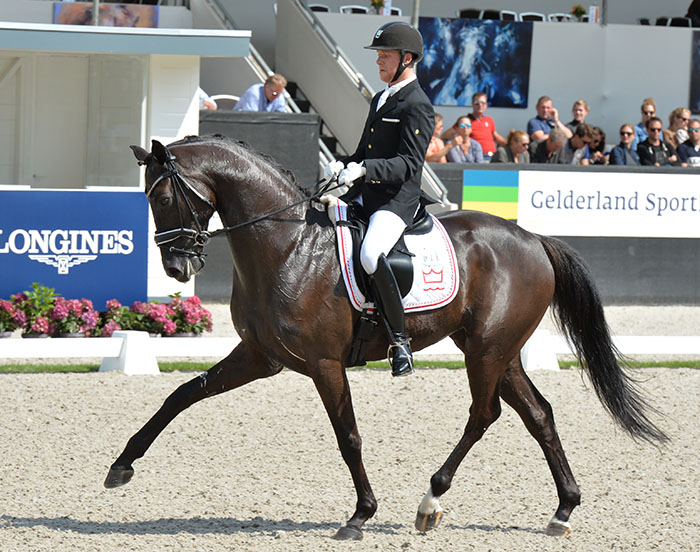
San Droneur by San Amour from a De Niro mare, for Denmark
There are twelve ‘S’ line entries in this year’s contest. Only two by Sandro Hit (Sandro Song / Ramino) himself but there are four from the son, San Amour (Plaisir d’Amour) and two Soliman de Hus (out of a Donnerhall / Alabaster mare), with individual representatives from Sancisco (Rohdiamant), Sarkozy (Weltmeyer) and the full-brothers, Sir Donnerhall I and II (out of a Donnerhall mare, although she descends on her mare line from the Frediksborg horse, a Danish breed of carriage horses).
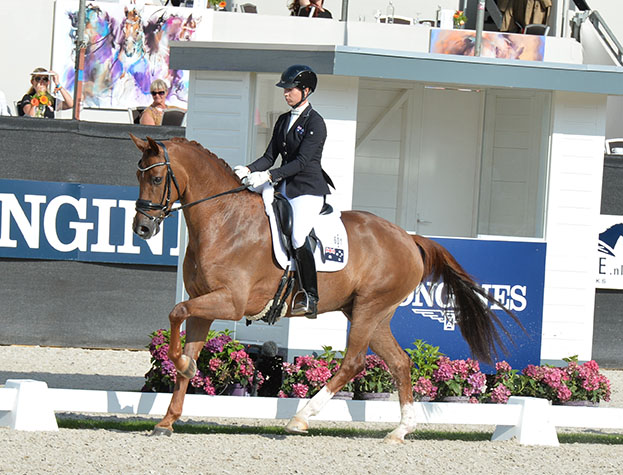
Gerion, by Jazz and into the 6yo Final for Austalia’s Briana Burgess
The Dutch breeding star, Jazz (Cocktail / Ulster) has three of his get in the line-up, while his son, Johnson has one and there’s one by his grandsons, Bretton Woods (Johnson / De Niro) and Zizi Top (Tango / Ferro) and two from his great grandson, Apache (UB 40 / Krack C). There are two by the Jazz son, Don Juan de Hus (out of a Krack C mare) but both of them make the five-year-old final – including the champion.
The D line of Donnerhall, which dominates Grand Prix competition is not quite so overwhelming in the young horse world, but the D line still provides ten of the entrants. None by the great Donnerhall himself, but two by the recently deceased Dancier (De Niro / Lancier) and two by the German team member, Desperados FRH (De Niro / Wolkenstein II) – then one each for Damon Hill (Donnerhall / Rubinstein), Danone (De Niro / Weltmeyer), Diamo Gold (Dimaggio / Ex Libris), Don Primus (Don Primero / Sandro Hit), Don Diamond (Diamond Hit / Carolus I), Dancing Hit (by the Dressage Royal son, Uno Don Diego out of a Sandro Hit mare) and one by Don Schufro (Donnerhall / Pik Bube I).
Quaterback (Quaterman / Brandenburger) was another whose career peaked at the Bundeschampionate, in 2006 when he swept all before him to take the Three-Year-Old Stallion championship, and while there has been talk of higher level performances since then, the news had not made its way to the FEI database. Quaterback has three flag-bearers at Ermelo and his son, Quasar de Charry (out of a Wolkentanz I mare) has one.
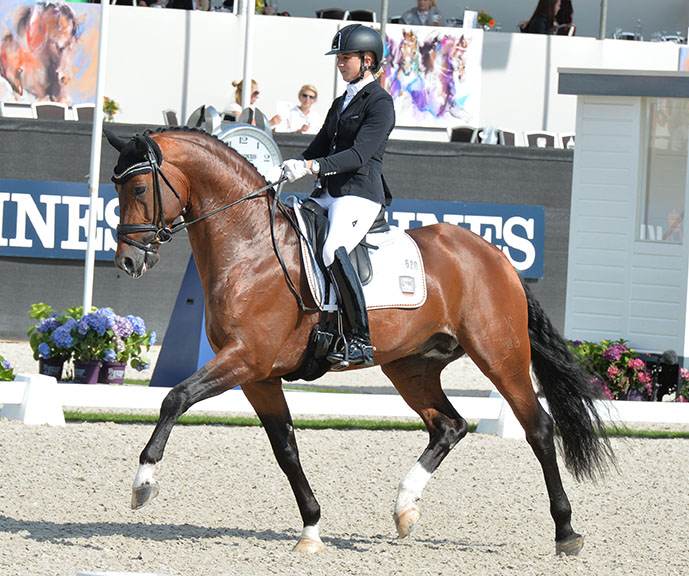
Nymphenburg’s First Ampere (Ampere/Weltruhm)
There are three by Ampère (Rousseau / Flemmingh) and Bordeaux (United / Gribaldi).
Then there are a little clutch of descendants of the great Furioso II, through his grand son Florestan:
Fürstenball (Fürst Heinrich / Donnerhall) was himself a young horse star, and he certainly seems to be producing his share of attractive youngsters, he has three, two by Foundation (Fidertanz / De Vito), two by Fassbinder (Fürst Heinrich / Caprimond), the one each for Floricello (Florencio / Dormello), Faustinus (Fürst Heinrich / Starway), Fürst Romancier (Fürst Heinrich / Romancier), Fürst Piccolo (Fidermark / Mephistopheles)
Romanov (Rohdiamant / Grundstein II) has three to sort of keep the Rubinstein banner happening.
In the end it was the Hanoverians who claim boasting rights with two champions, with the third from the Danish Warmblood book.


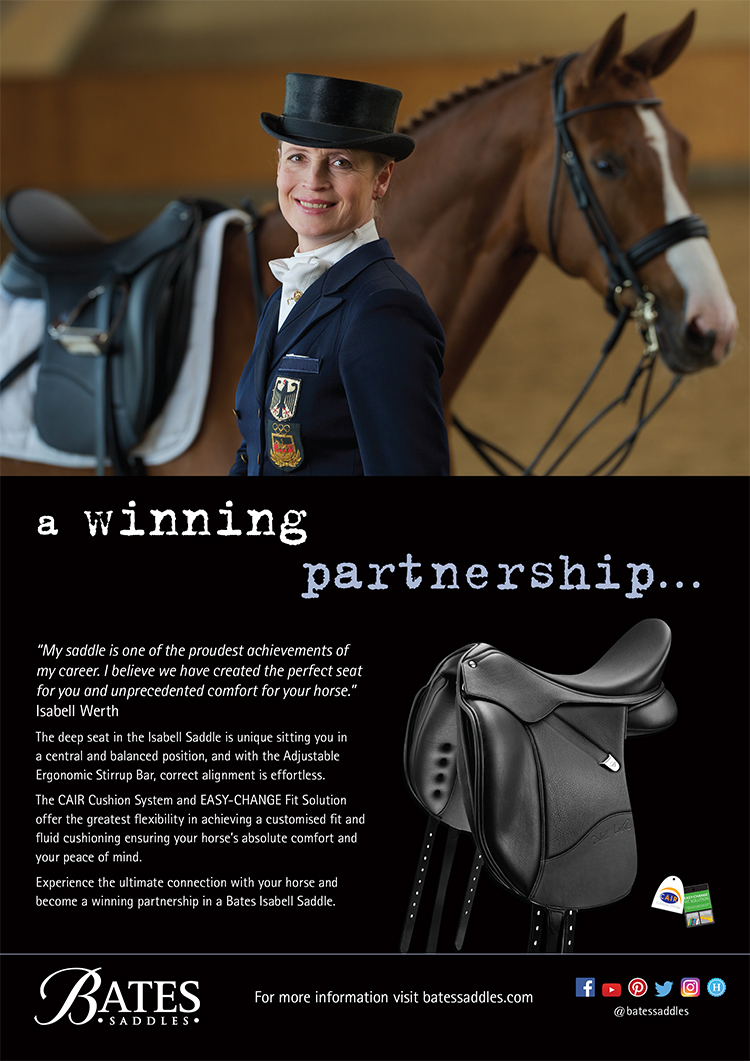


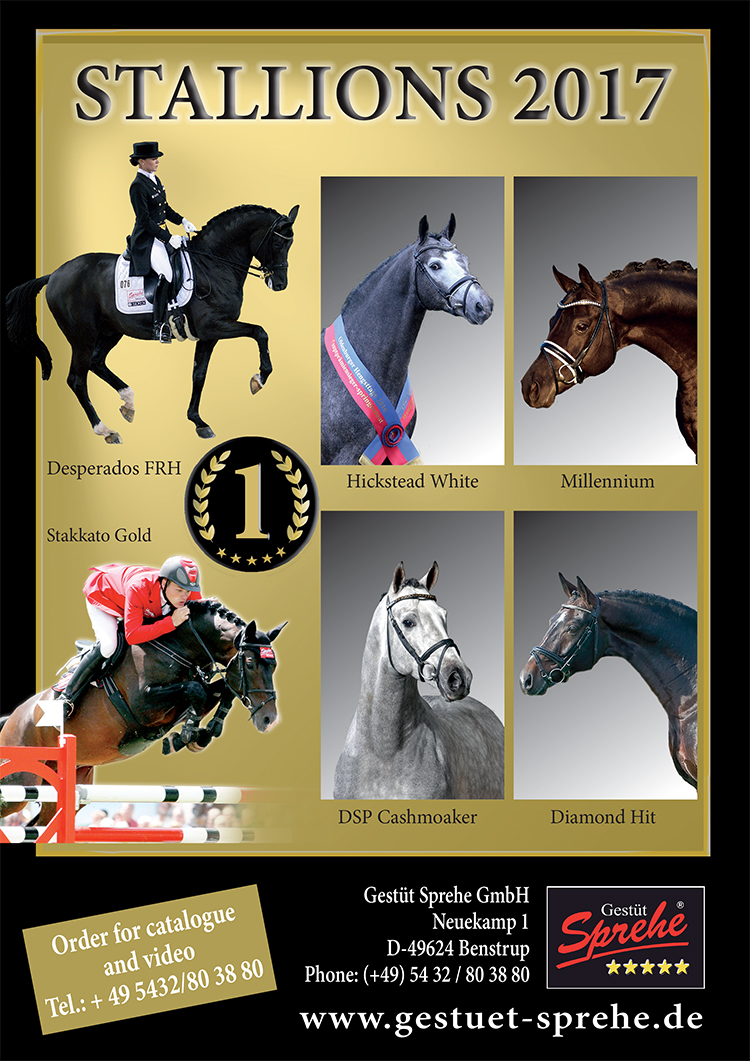
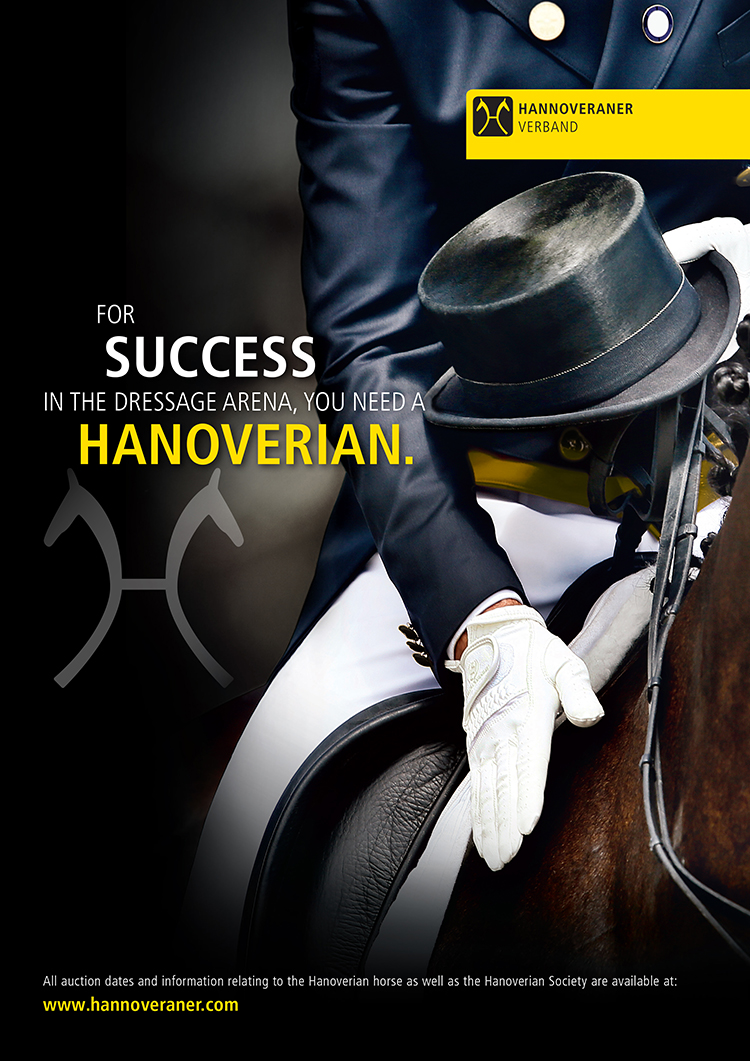
Fiontini was there representing the Danish Warmblood. She did her trial there to qualify.
The loud noise you hear is us clapping heartily in the US ,for the quality of reporting and the willingness to call a spade a spade – this is the greatest equestrian publication of all time, I am convinced. Horse Magazine is not afraid to name names and ruffle feathers in defense of horses, thank you sincerely for this. Seeing public pressure turn a mean-spirited, robotic asshole like Helgstrand into a more sympathetic rider is wonderful to see, and will no doubt benefit countless future horses who go through his hands.
The expression on Henke’s face is unbelievable, he looks distressed and sad. He’s probably afraid she’ll break his jaw, awful, awful woman.
Really enjoyed the piece. Except for one error – the photo and interview must not be from Ann-Christine Wienkamp. You are talking to/about the rider of Dancing Diamond who is ridden by Anne-Kathrin Pohlmeier.
“You must remember with a stallion that Edward Gal is riding, the offspring are coming from the stallion, not from Edward” – bahahahahahahaha.
Best line in the whole article!
Thank you for telling it like it is! This is how journalism in dressage should ALWAYS be conducted. No sensationalizing the uncomfortable truth, and rewarding riders for turning over a new leaf. I wholeheartedly support this article.
Well done, Chris, on another fabulous article. I love your work! Now to educate the public about the difference between a leg mover and a back mover. Introducing Dr Gerd Heuschmann’s latest book on the subject. Highly recommended reading for all riders and coaches. https://www.youtube.com/watch?v=VIq69M2zbg4
Great Article. Thank you Chris